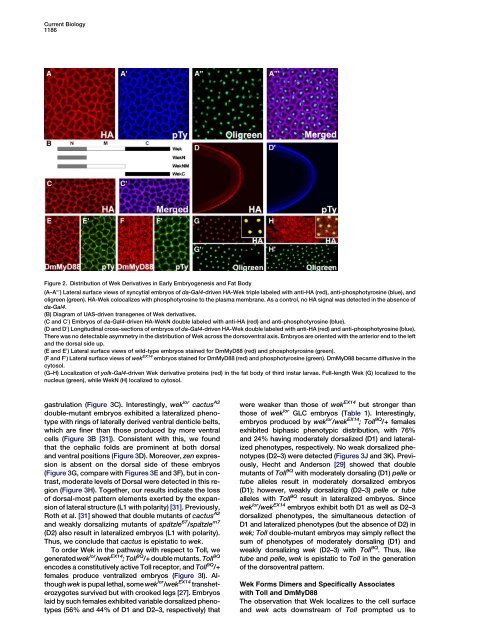Article Weckle Is a Zinc Finger Adaptor of the Toll Pathway in ...
Article Weckle Is a Zinc Finger Adaptor of the Toll Pathway in ...
Article Weckle Is a Zinc Finger Adaptor of the Toll Pathway in ...
You also want an ePaper? Increase the reach of your titles
YUMPU automatically turns print PDFs into web optimized ePapers that Google loves.
Current Biology<br />
1186<br />
Figure 2. Distribution <strong>of</strong> Wek Derivatives <strong>in</strong> Early Embryogenesis and Fat Body<br />
(A–A 000 ) Lateral surface views <strong>of</strong> syncytial embryos <strong>of</strong> da-Gal4-driven HA-Wek triple labeled with anti-HA (red), anti-phosphotyros<strong>in</strong>e (blue), and<br />
oligreen (green). HA-Wek colocalizes with phosphotyros<strong>in</strong>e to <strong>the</strong> plasma membrane. As a control, no HA signal was detected <strong>in</strong> <strong>the</strong> absence <strong>of</strong><br />
da-Gal4.<br />
(B) Diagram <strong>of</strong> UAS-driven transgenes <strong>of</strong> Wek derivatives.<br />
(C and C 0 ) Embryos <strong>of</strong> da-Gal4-driven HA-WekN double labeled with anti-HA (red) and anti-phosphotyros<strong>in</strong>e (blue).<br />
(D and D 0 ) Longitud<strong>in</strong>al cross-sections <strong>of</strong> embryos <strong>of</strong> da-Gal4-driven HA-Wek double labeled with anti-HA (red) and anti-phosphotyros<strong>in</strong>e (blue).<br />
There was no detectable asymmetry <strong>in</strong> <strong>the</strong> distribution <strong>of</strong> Wek across <strong>the</strong> dorsoventral axis. Embryos are oriented with <strong>the</strong> anterior end to <strong>the</strong> left<br />
and <strong>the</strong> dorsal side up.<br />
(E and E 0 ) Lateral surface views <strong>of</strong> wild-type embryos sta<strong>in</strong>ed for DmMyD88 (red) and phosphotyros<strong>in</strong>e (green).<br />
(F and F 0 ) Lateral surface views <strong>of</strong> wek EX14 embryos sta<strong>in</strong>ed for DmMyD88 (red) and phosphotyros<strong>in</strong>e (green). DmMyD88 became diffusive <strong>in</strong> <strong>the</strong><br />
cytosol.<br />
(G–H) Localization <strong>of</strong> yolk-Gal4-driven Wek derivative prote<strong>in</strong>s (red) <strong>in</strong> <strong>the</strong> fat body <strong>of</strong> third <strong>in</strong>star larvae. Full-length Wek (G) localized to <strong>the</strong><br />
nucleus (green), while WekN (H) localized to cytosol.<br />
gastrulation (Figure 3C). Interest<strong>in</strong>gly, wek lor cactus A2<br />
double-mutant embryos exhibited a lateralized phenotype<br />
with r<strong>in</strong>gs <strong>of</strong> laterally derived ventral denticle belts,<br />
which are f<strong>in</strong>er than those produced by more ventral<br />
cells (Figure 3B [31]). Consistent with this, we found<br />
that <strong>the</strong> cephalic folds are prom<strong>in</strong>ent at both dorsal<br />
and ventral positions (Figure 3D). Moreover, zen expression<br />
is absent on <strong>the</strong> dorsal side <strong>of</strong> <strong>the</strong>se embryos<br />
(Figure 3G, compare with Figures 3E and 3F), but <strong>in</strong> contrast,<br />
moderate levels <strong>of</strong> Dorsal were detected <strong>in</strong> this region<br />
(Figure 3H). Toge<strong>the</strong>r, our results <strong>in</strong>dicate <strong>the</strong> loss<br />
<strong>of</strong> dorsal-most pattern elements exerted by <strong>the</strong> expansion<br />
<strong>of</strong> lateral structure (L1 with polarity) [31]. Previously,<br />
Roth et al. [31] showed that double mutants <strong>of</strong> cactus A2<br />
and weakly dorsaliz<strong>in</strong>g mutants <strong>of</strong> spa¨tzle 67 /spa¨tzle m7<br />
(D2) also result <strong>in</strong> lateralized embryos (L1 with polarity).<br />
Thus, we conclude that cactus is epistatic to wek.<br />
To order Wek <strong>in</strong> <strong>the</strong> pathway with respect to <strong>Toll</strong>, we<br />
generated wek lor /wek EX14 ;<strong>Toll</strong> 9Q /+ double mutants. <strong>Toll</strong> 9Q<br />
encodes a constitutively active <strong>Toll</strong> receptor, and <strong>Toll</strong> 9Q /+<br />
females produce ventralized embryos (Figure 3I). Although<br />
wek is pupal lethal, some wek lor /wek EX14 transheterozygotes<br />
survived but with crooked legs [27]. Embryos<br />
laid by such females exhibited variable dorsalized phenotypes<br />
(56% and 44% <strong>of</strong> D1 and D2–3, respectively) that<br />
were weaker than those <strong>of</strong> wek EX14 but stronger than<br />
those <strong>of</strong> wek lor GLC embryos (Table 1). Interest<strong>in</strong>gly,<br />
embryos produced by wek lor /wek EX14 ;<strong>Toll</strong> 9Q /+ females<br />
exhibited biphasic phenotypic distribution, with 76%<br />
and 24% hav<strong>in</strong>g moderately dorsalized (D1) and lateralized<br />
phenotypes, respectively. No weak dorsalized phenotypes<br />
(D2–3) were detected (Figures 3J and 3K). Previously,<br />
Hecht and Anderson [29] showed that double<br />
mutants <strong>of</strong> <strong>Toll</strong> 9Q with moderately dorsal<strong>in</strong>g (D1) pelle or<br />
tube alleles result <strong>in</strong> moderately dorsalized embryos<br />
(D1); however, weakly dorsaliz<strong>in</strong>g (D2–3) pelle or tube<br />
alleles with <strong>Toll</strong> 9Q result <strong>in</strong> lateralized embryos. S<strong>in</strong>ce<br />
wek lor /wek EX14 embryos exhibit both D1 as well as D2–3<br />
dorsalized phenotypes, <strong>the</strong> simultaneous detection <strong>of</strong><br />
D1 and lateralized phenotypes (but <strong>the</strong> absence <strong>of</strong> D2) <strong>in</strong><br />
wek; <strong>Toll</strong> double-mutant embryos may simply reflect <strong>the</strong><br />
sum <strong>of</strong> phenotypes <strong>of</strong> moderately dorsal<strong>in</strong>g (D1) and<br />
weakly dorsaliz<strong>in</strong>g wek (D2–3) with <strong>Toll</strong> 9Q . Thus, like<br />
tube and pelle, wek is epistatic to <strong>Toll</strong> <strong>in</strong> <strong>the</strong> generation<br />
<strong>of</strong> <strong>the</strong> dorsoventral pattern.<br />
Wek Forms Dimers and Specifically Associates<br />
with <strong>Toll</strong> and DmMyD88<br />
The observation that Wek localizes to <strong>the</strong> cell surface<br />
and wek acts downstream <strong>of</strong> <strong>Toll</strong> prompted us to



